When I lived in Rome, I ate a lot of Carciofi alla Giudia, or Roman-Jewish Fried Artichoke. Something about the crispy, caramelized artichoke leaves with a bit of lemon juice was so addicting! This air fryer artichoke recipe is a play on that traditional recipe (with some inspiration from Tori Avey's Jewish Fried Artichoke recipe). Enjoy!
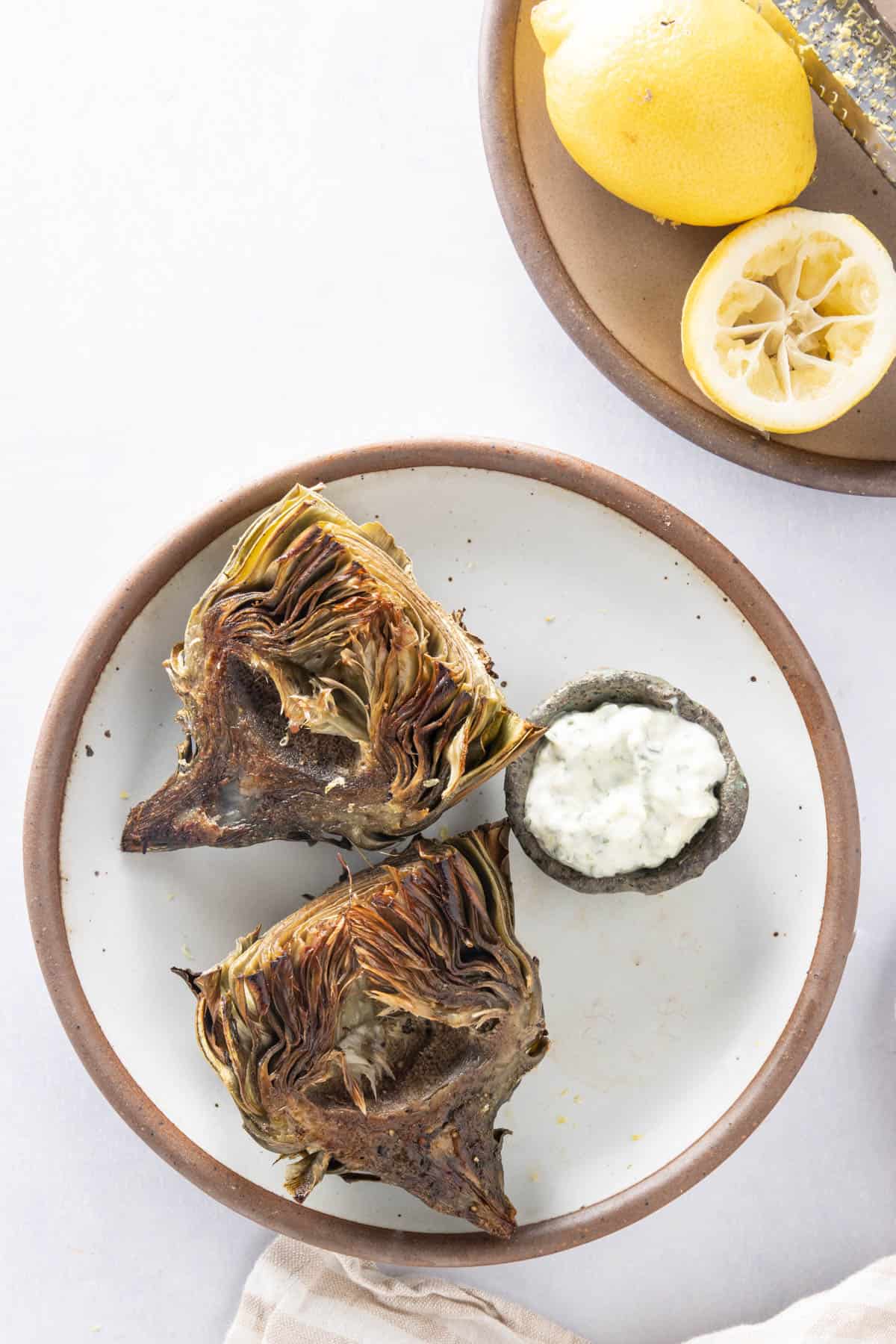
This post contains helpful tips and tricks! If you're in a rush, please use the "Jump to Recipe" below!
💭 Why you'll love this recipe
- Learn how to cook artichokes. Folks are often intimidated by artichokes, but they're so easy to cook! There are step-by-step instructions included so you can get it right the first time!
- Super nutritious. Fresh artichokes are packed full of nutrients. They have tons of fiber, a great amount of vitamins, and even anti-oxidants. Jerusalem artichokes are considered a "prebiotic" as well.
- Easy, vegan, 45 minute recipe. Forget boring old steamed or boiled artichokes (though they're great too!) These air fryer artichokes are made with five ingredients and bound to become a crispy snack you can't get enough of once you try them!
⭐Origin story
Carciofi alla Giudia, or Roman-Jewish fried artichokes are really one of the early dishes that pushed this vegetable into popularity. When I lived in Rome, I learned about the Jewish Ghetto (Rione Sant'Angelo) of the 1500s, where people improvised to cook on open fires. The whole fried artichokes were born as a result of this scarcity and improvisation.
The Italian version of this dish, fried whole, is made with Romanesco artichokes (which are purple). Artichokes in the US are mostly "globe" artichokes. This air fryer artichoke recipe tries to replicate the original texture by roasting them as halves instead of the whole. I love serving this with another Roman favorite - authentic cacio e pepe.
📋 Ingredients and notes
You'll need a whole artichoke, avocado oil, salt, pepper, and lemons for this recipe. You can also add seasoning (e.g., garlic powder, cayenne, or even garam masala for a warm cultural twist!)
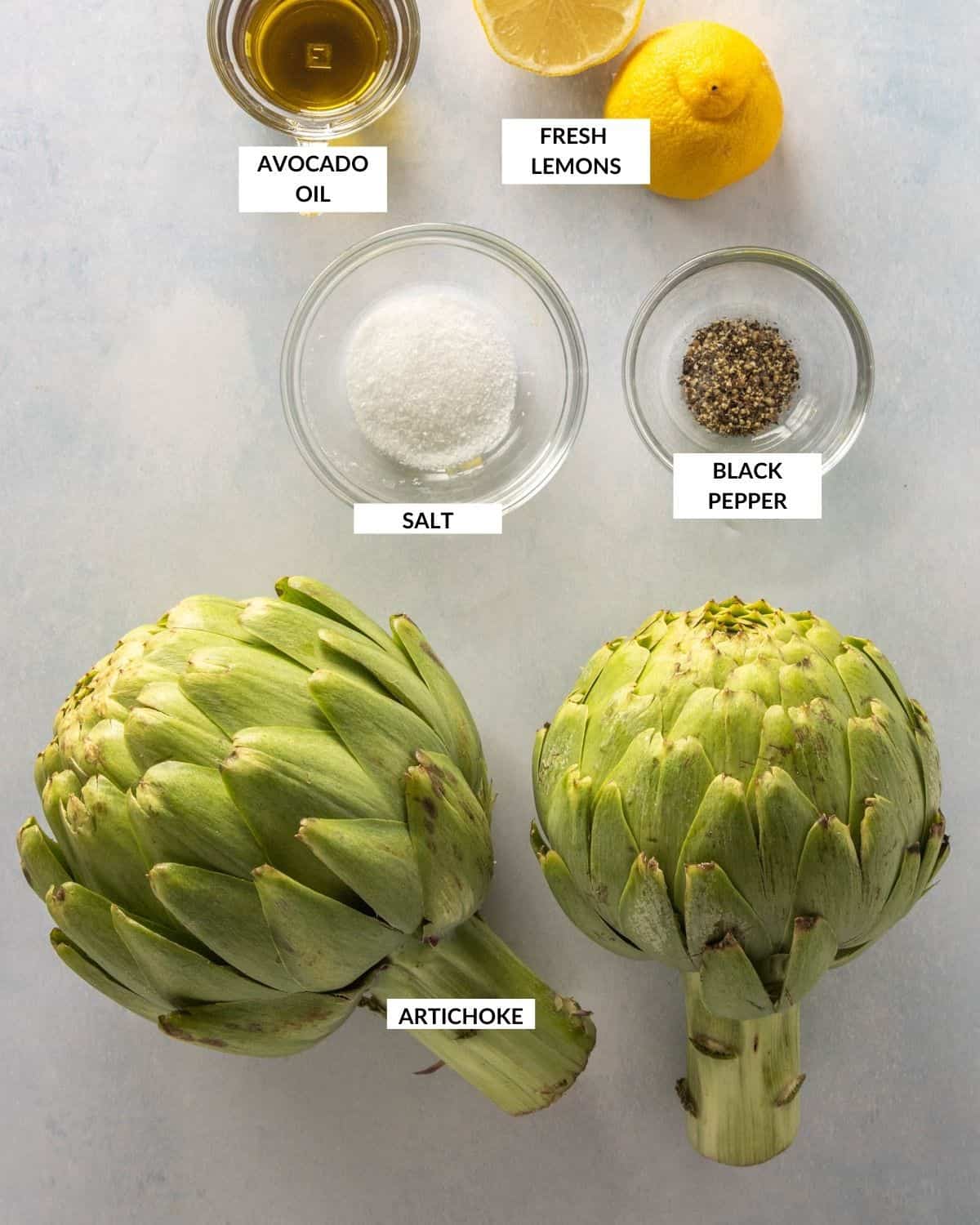
How to pick artichokes
There are three simple rules I follow when picking artichokes:
- Find artichokes with leaves that are really tight (and closed)
- Many artichokes will have a scarred appearance (mostly due to frost) - this is normal! We'll also remove the outer leaves before cooking them
- Find artichokes where the leaves are not shriveled towards the top
📖 Step-by-step instructions
"What parts of the artichoke can I eat?" is the most common question I get asked about artichokes. So, I've outlined the basic parts below, and have detailed instructions to show you how you can get from what you see to the parts you can actually use.
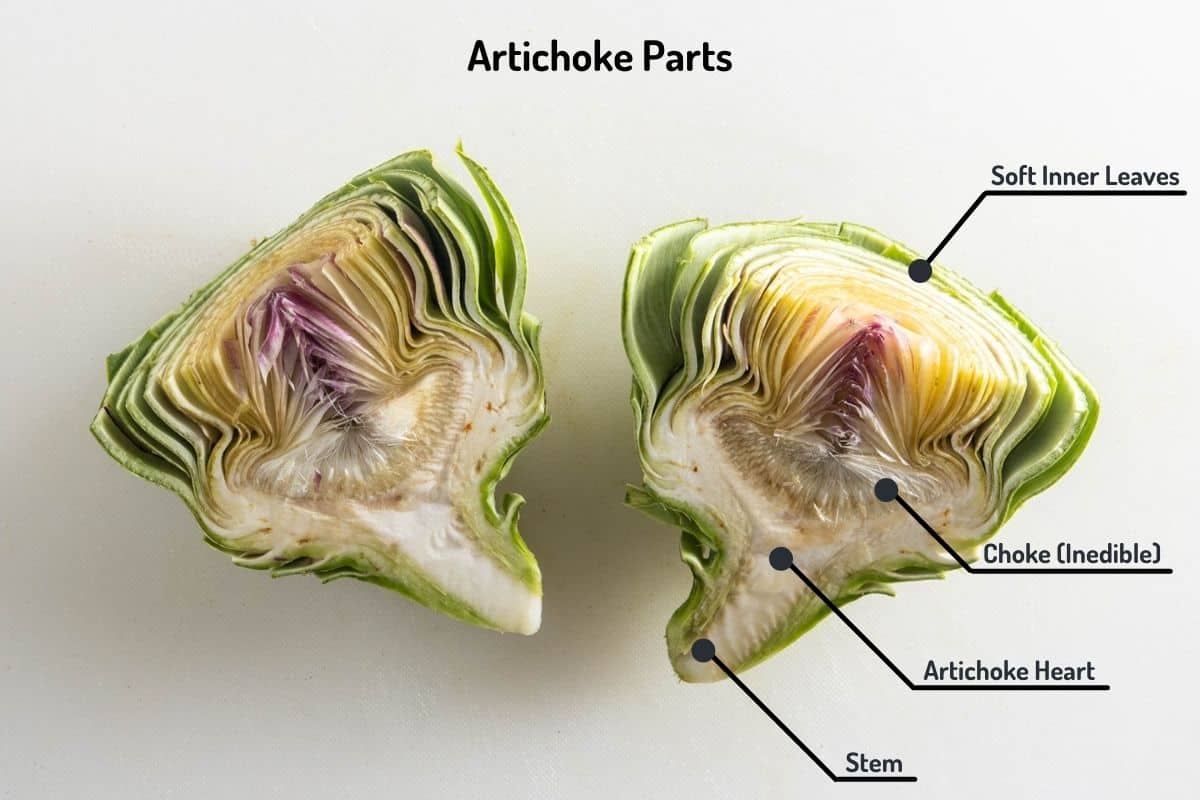
Prepare the artichokes
Note: A substantial part of the artichoke is typically inedible (for instance, most of the outer leaves, and a good portion of the upper parts that are more prickly). So, if you get to retain a third of the artichoke (mainly the soft leaves, heart, and a part of the stem) - you're in good shape.
Artichokes are like avocados - exposure to air will usually turn them brown. So, before you start preparing your artichokes, cut a lemon into halves, squeeze the juice into a bowl of ice water, and then drop the wedge into the bowl. Set this aside - once the artichokes are prepared, you'll want to rub it with lemon juice and then drop it into this bowl to preserve it's rich green color!

- Snip the sharp edges of the leaves with a pair of scissors
- Slice off the stem leaving about an inch close to the globe
- Use a serrated peeler to shave off the tough outer parts of the stem
- Rub the stem with a lemon wedge immediately to prevent browning
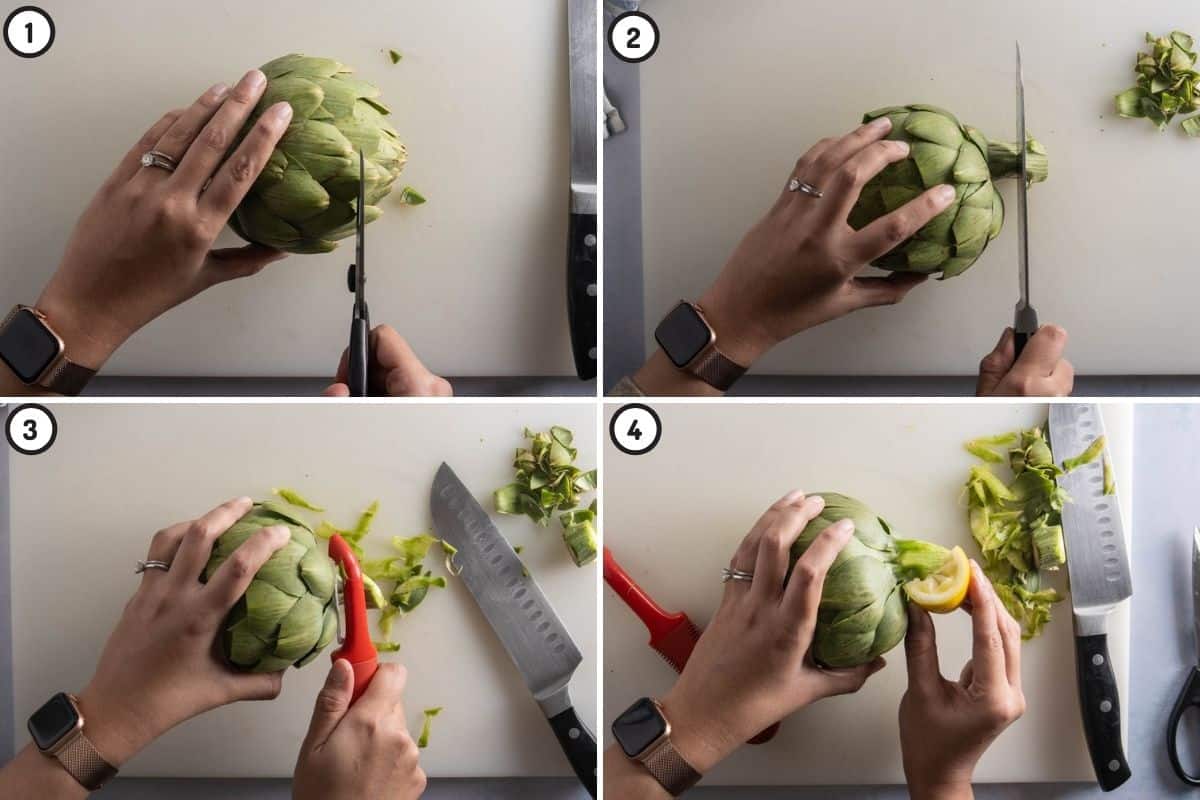
- Remove the tough outer leaves (especially scarred ones) - I find that I usually remove 3 to 4 layers per artichoke.
- Starting from where the stem meets the globe, leave about ½ to ¾th of an inch, and slice off the top part of the artichoke - these leaves are typically tough and inedible.
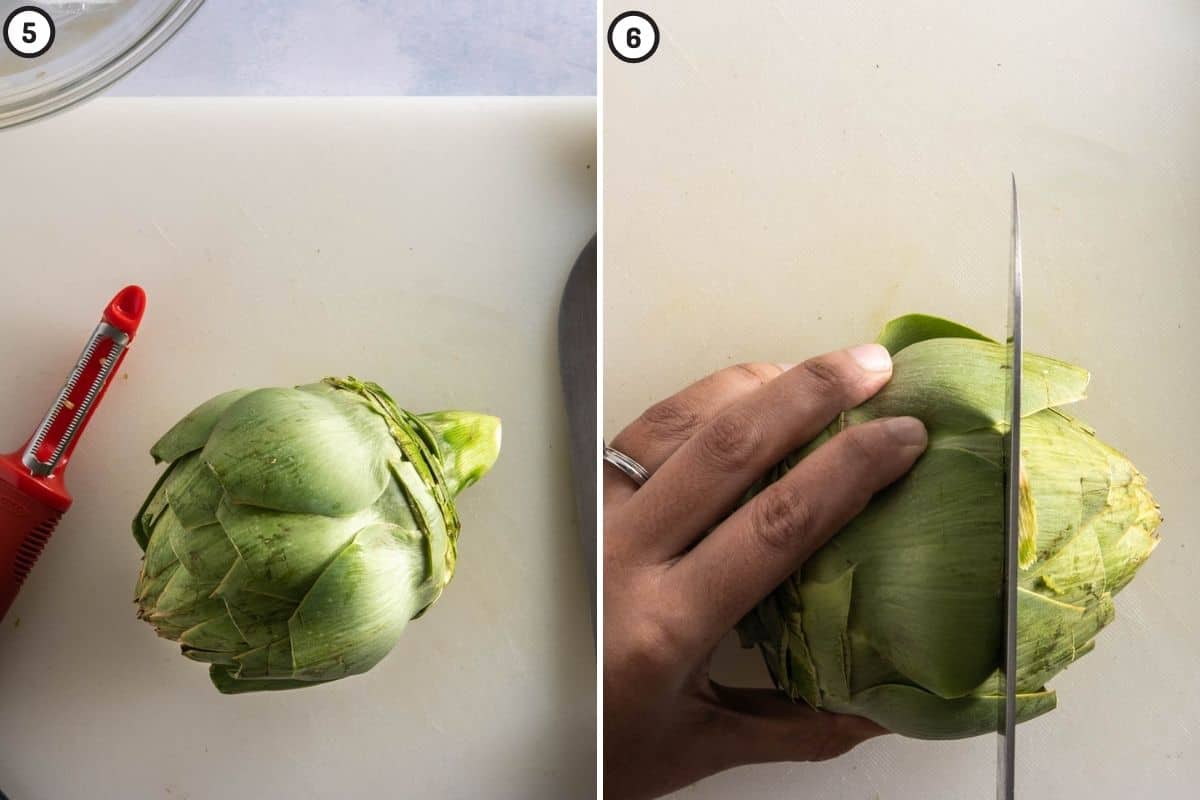
Typically I shoot for where the leaves are "white" that's the soft part that's edible. Once you slice the artichoke, you'll see the inner purple leaves exposed too!
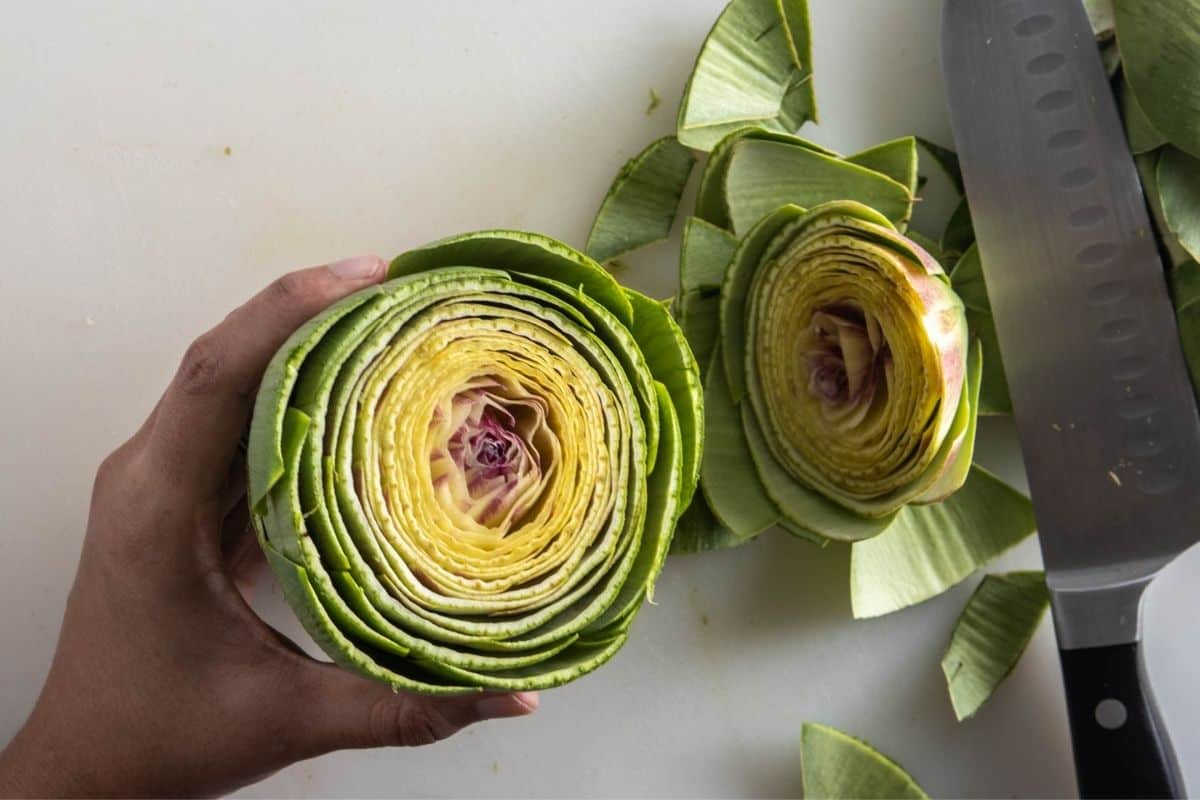
- Slice the part vertically through the stem so you can get two halves. Rub lemon on the part that you're not going to prepare first.
- If you look closely you'll see a bunch of fluffy stuff at the middle - this is the "choke" of the artichoke (aka underdeveloped new leaves) This is not edible, so use a spoon to remove the fluff
- Rub some lemon on the exposed edges and place it in the lemon water until you prepare the other half of the artichoke
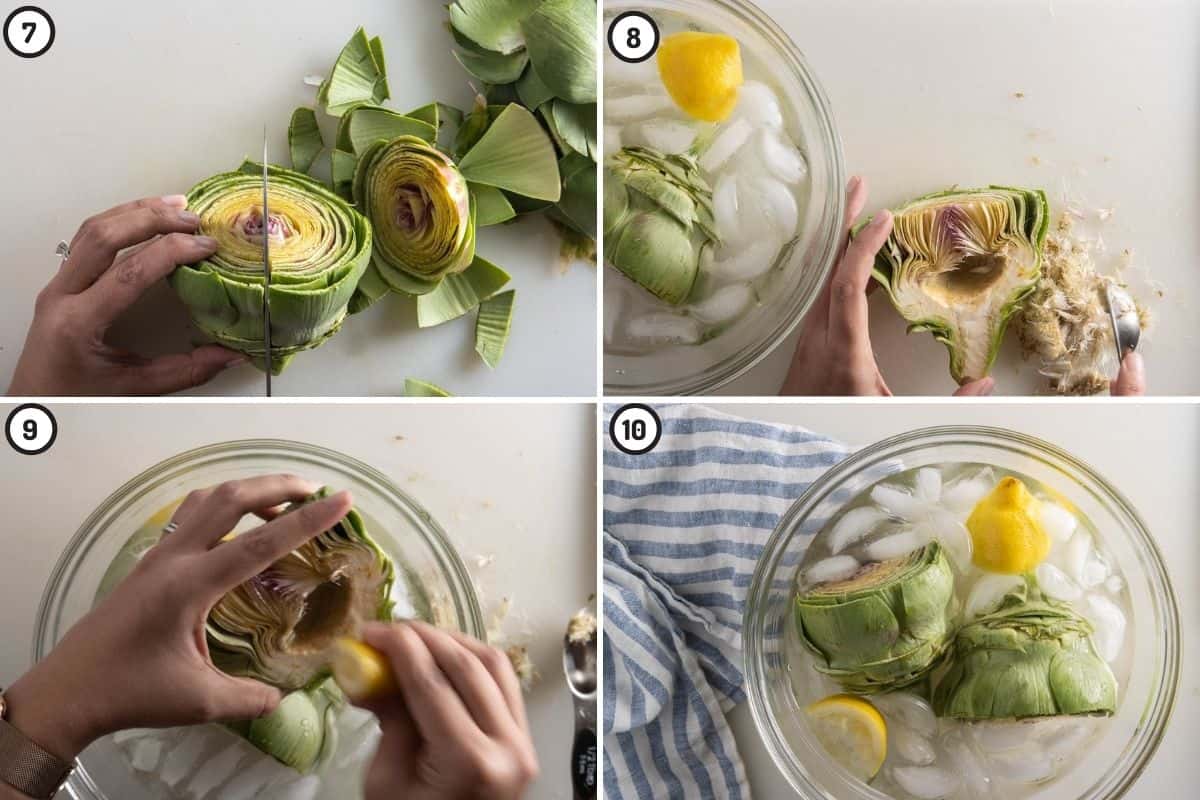
Parboil, then season the artichokes
You're mostly done with the process! Preheat your air fryer to 375F if you need to at this stage.
- Taking care not to tip the artichokes, add the lemon water to a pot and bring the water to boil on high heat. Place a steamer basket, strainer, or even a close fitting bowl in the pot (as a double boiler) and steam the artichoke for about 10-15 minutes. You'll know this is done when you can insert a fork through the stem. Don't overcook it - just parboil!
- Then, dry the artichokes thoroughly using a kitchen towel. Place them cut side up on your air fryer tray or basket, and drizzle some avocado oil, salt, and pepper and rub them into the flat side of the artichoke. I use avocado oil since it's a higher smoke point and a fairly neutral oil.
- Flip the artichoke so the flat side is now down, and drizzle the remaining avocado oil and rub it into this surface as well.
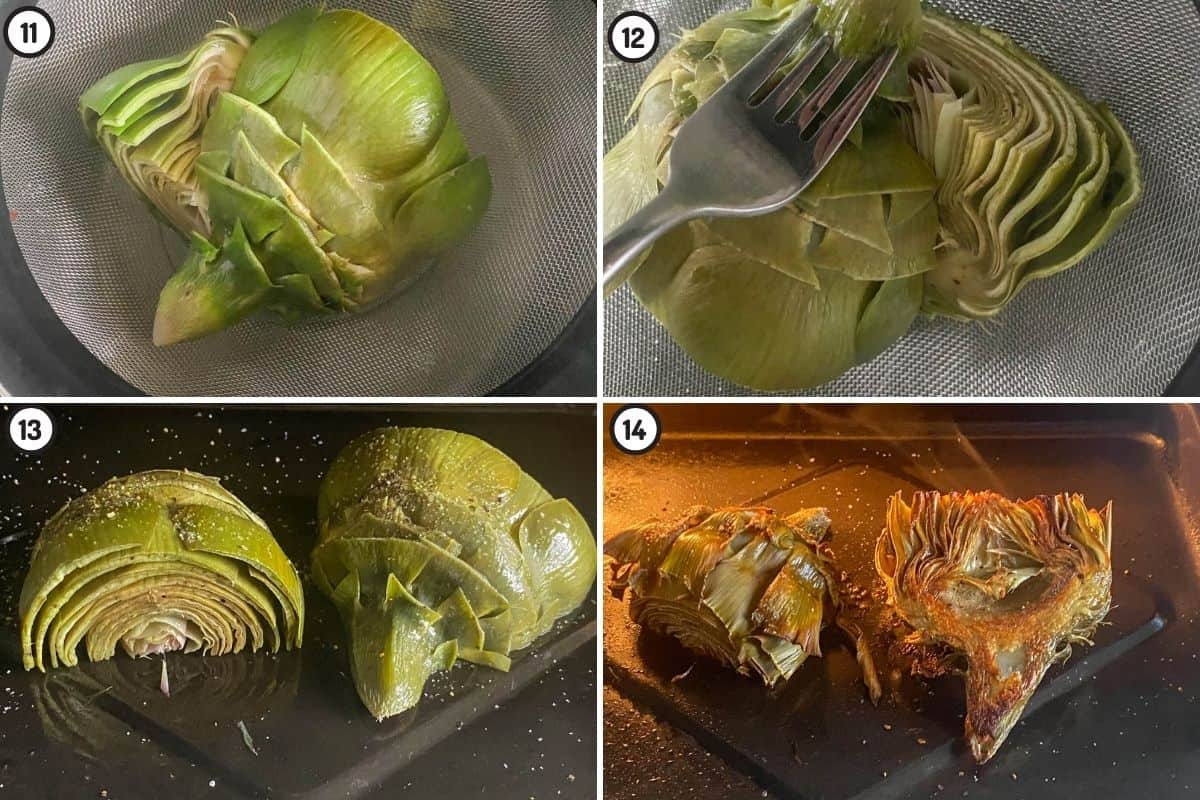
Throw in the air fryer!
Now, place the artichokes with the flat side down on the basket or tray of your air fryer. I typically finish off with a little more avocado oil on the top, or a spritz of avocado oil spray if you have some on hand. Roast for about 10 to 15 minutes, checking every minute after the 10 minute mark.
The time it takes will really depend on the size of the artichoke, but I find that it takes around 12 minutes for a perfect "fry" on mine!
Serve the roasted air fryer artichokes with your favorite creamy dipping sauce. I love to use a basil mayo or mayo with lemon zest!
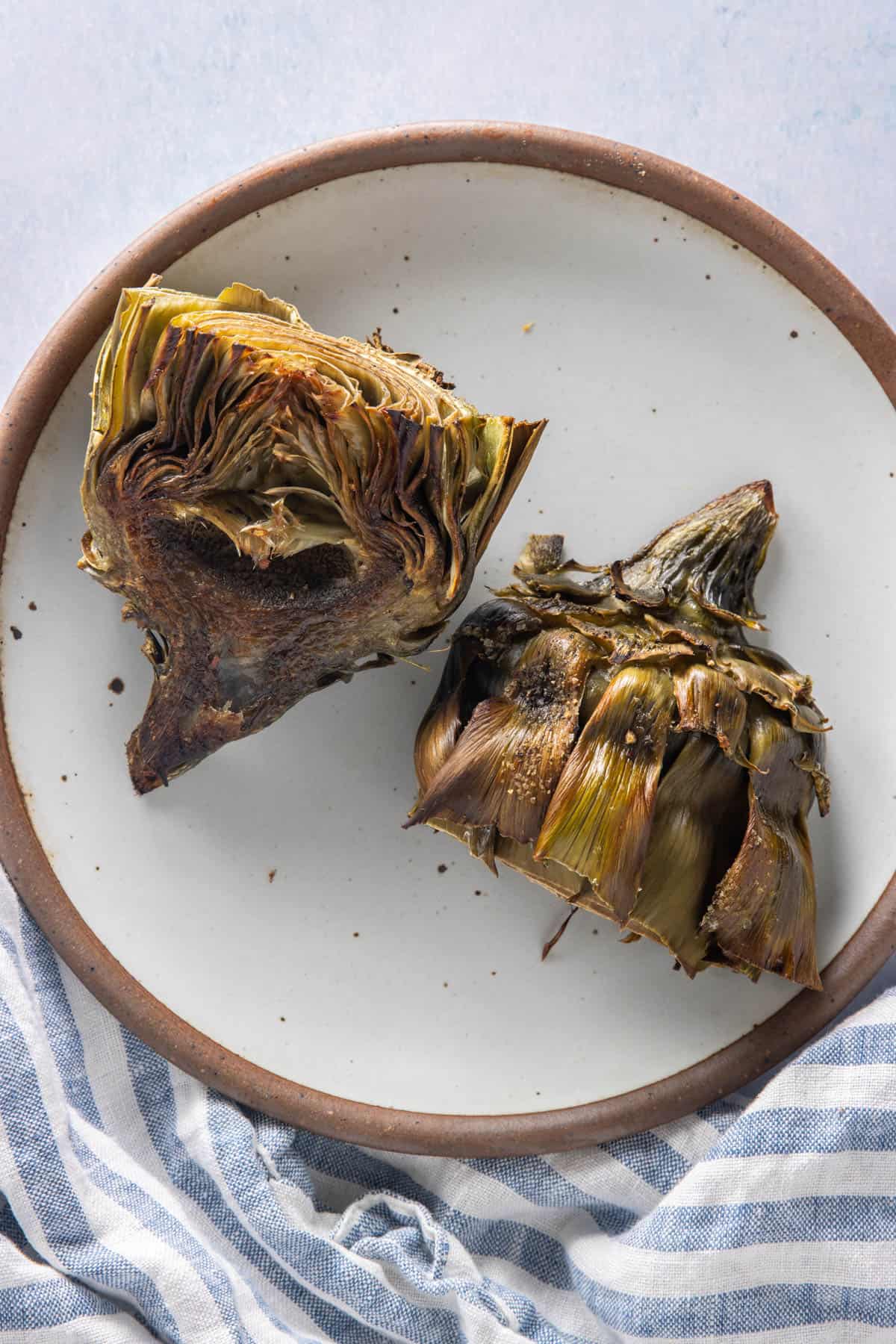
👩🏽🍳Top tips and FAQs
You can eat the inner leaves and hearts whole! Depending on where you cut the top off, some parts of the leaves are less soft. For those, I scrape the fleshy part with my teeth. To do this, pick up a leaf, put it between your front teeth and pull it out to scrape the underside.
I love making a basil aioli with mayonnaise and basil, garlic, and lemon zest to serve with this artichoke. You can also just drizzle some lemon juice and eat it as it is.
🍴 Serving and storage suggestions
I've never had leftover artichokes when I make it this way. But it stays okay in the fridge for a day. Just make sure to throw it in the oven or air fryer to reheat and not the microwave!
If you like this recipe, don't forget to try out my other spring recipes:
If you tried this recipe, don't forget to comment and rate! ⭐⭐⭐⭐⭐
📖 Recipe
Air Fryer Artichokes
Equipment
Ingredients
- 1 artichoke
- 2 tablespoons avocado oil
- 1 teaspoon kosher salt
- ½ teaspoon black pepper
- 2 lemons, organic if possible
Instructions
- Preheat your air fryer to 375°F (or if using an oven, 400°F)
Prepare the Artichokes
- Slice a lemon into halves. Squeeze one half into a medium bowl of ice water, and add the lemon half to the bowl and set aside. Lemon juice helps prevent browning of artichokes (tip from Tori Avey). I suggest using a pot to do this since you'll be boiling the artichokes in this water later - save on dishes!
- Wash your artichoke thoroughly and dry them with a kitchen towel. Then, using a sharp pair of scissors, snip off the tips of the larger, outer leaves. This will ensure that you can eat more of the leaves. Don't worry about snipping the very tops since we'll slice off a portion of the upper part before air frying.
- Next, using a sharp knife, cut off the end of the stem, leaving about an inch of it still attached to the artichoke. This part tastes delicious once fried! Use a peeler to shave off the outer surface of the stem - this is typically quite bitter. Then, rub with the other lemon half, and set aside.
- Then, peel off roughly 4 to 5 layers of external leaves using your hands or a pair of scissors (it typically snaps right off). You want to do this until you reach the inner leaves of the artichoke, that are typically white at the base. While this might seem like waste, these outer leaves are typically inedible (especially once fried) - so you'll likely discard a lot of them while eating anyway! Once you do this, you should have about ⅔rds of the artichoke leaves.
- Lay the artichoke on it's side and cut it into two horizontal halves with a sharp chef’s knife. I aim for about an half inch above the base (heart) so you can remove the top of the artichoke. Then, slice it into two halves through the stem.
- If you look closely you'll see a bunch of fluffy stuff at the middle - this is the "choke" of the artichoke (aka underdeveloped new leaves) This is not edible, so use a spoon to remove the fluff or the choke and discard. You can also run it under cold water to remove any stubborn bits! Once this is done, rub the artichoke with the same half lemon you used on the stem (and you can squeeze some of the juice on top as well) and place into the bowl with lemon water while you prepare the other half. This will make sure your artichokes stay fresh and green!
Parboil
- Remove the artichokes from water and place on a clean kitchen towel. Then, place the pot of lemon water on the stove and bring to a boil. You'll want a couple of inches of water, so add some more water if needed. Place a steamer basket or a smaller glass bowl that can balance on the edges of the pot (so it's not actually submerged in the water). Then, place the artichoke halves in the steamer basket, reduce heat to medium, and cover with lid. I typically steam the artichokes for about 10 minutes (but depending on the size, this might be closer to 15-20). You should be able to pierce a fork smoothly into the thickest part of the stem when it's parboiled properly - don't cook them fully, just parboil!
Season and Air Fry!
- Then, place the steamed artichokes on your air fryer tray or basket. Drizzle a tablespoon of avocado oil on the hollow side, and season with a teaspoon of salt and half a teaspoon of black pepper. Use your hands to thoroughly rub it into the artichokes.
- Place the artichokes flat side down on the air fryer basket or tray. Then, pour the remaining tablespoon of avocado oil on the top side of the artichoke and use your hands to coat well.
- If using an air fryer, air fry at 375°F for 10 minutes. Then, check every minute for up to 5 more minutes to get to perfect golden brown roasted artichokes. If using an oven, you'll need to roast uncovered for 15 minutes, then cover with foil and roast for another 25 minutes!
- Serve hot with a dip of your choice (like this basil aioli) and enjoy!
Notes
- Picking artichokes: You'll want to pick artichokes with tight leaves! Scarring is expected (typically due to frost) but avoid ones that are shriveled up. You'll also want artichokes to weigh heavier than you think they will (this means there's tons of moisture and it's not dried up!)
- How much of the artichoke can you actually eat? It might seem wasteful, but a large chunk of the artichokes are typically not fully edible. The parts that are most edible and best suited for this preparation are the soft inner leaves, the heart, and a part of the tender stem.
- Seasoning artichokes: I've used very simple seasoning in the recipe to stay true to how I remember eating this dish in Rome. However, you can easily add a couple of garlic cloves underneath the artichokes and roast them together. Or season with garlic powder, any herbs, or even your choice of "spicy" seasoning.
- Dipping sauces: I love chopping up some basil, and zesting some lemons, adding both of those to mayonnaise and serving that as the dipping sauce for this recipe. But honestly, you can just eat it by itself!






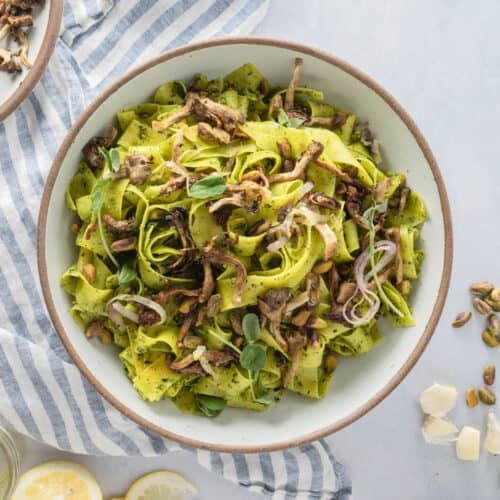
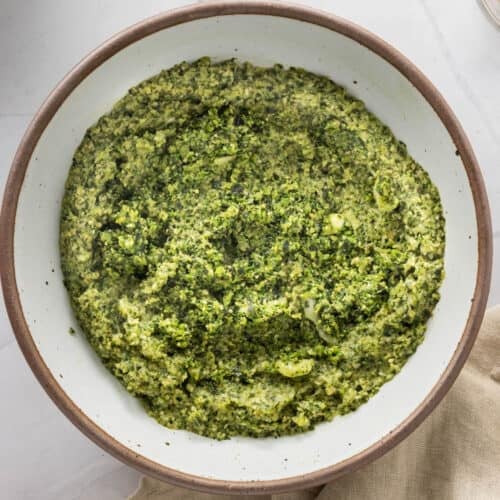











Comments
No Comments